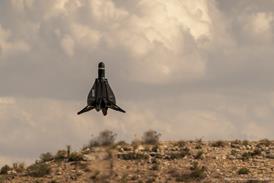Guy Norris/LOS ANGELES
Texas-based CarterCopter is working with NASA on design details of a hybrid proof-of-concept "Heliplane" transport which could be sized to meet the US Navy's requirement for a Grumman C-2A Greyhound replacement.
Design concepts have been completed for a range of hybrid "Heliplane" transports and utility aircraft, at least two of which are attracting strong interest from the navy, claims the company.
"We are trying to identify the size that is most likely to get funded and we are talking to the navy," it adds. Other than a C-2A/Bell Boeing V-22 Osprey sized proof of concept design - of around 22,700kg (50,000lb) maximum gross weight - the alternative most likely to be funded could be a smaller aircraft that would be sized to meet the requirement for the US Navy's medium-range unmanned air vehicle requirement.
The Heliplane builds on the CarterCopter concept which combines the features of a helicopter, gyroplane and fixed wing aircraft (Flight International, 28 March-3 April).
The Heliplane, which the company says could ultimately be expanded to Lockheed Martin C-130 Hercules proportions, will be capable of taking off, hovering and landing like a helicopter.
The company says that at speeds above 87kt (160km/h), the heliplane converts to a gyroplane by unloading the rotor and generating the lift from efficient high-aspect ratio wings, while also slowing the rotor to minimise profile drag.
Once in the cruise, the Heliplane would be able to operate at 370kt at 30,000ft (9,150m) and carry a 20,430kg payload for 1,290km with 45min fuel reserve. Range in short take-off and landing (as opposed to vertical take-off and landing) mode would be roughly three times this estimate, claims the company.
Turboprop engines, buried in the fuselage, would drive two four-bladed propellers through a two-speed planetary gearbox. A clutch would operate at zero torque, allowing the rotor to auto-rotate and begin slowing as the aircraft's weight transfers to the wing.
The composite pusher propellers would have a twistable spar and would not have a pitch change spindle, bearing or housing. Reverse pitch will allow the propellers to act as airbrakes.
Source: Flight International























